I’ve been using road racing shoes for trail running for quite some time now. Within this category, I typically look for shoes that feel fast and quick, are lightweight, and yet can still protect against the hazards of the trail.
Recently, I spent some time trying to narrow down the shoe(s) I intended to use for the 2015 Western States 100 Mile Endurance Run, and I thought a road shoe might be the best option, especially in the latter half of the race. Based on this process, I thought a post on using road shoes for trail running might be helpful. Before I share some of the shoes I’ve had good luck with on trails, I’d like to highlight a few things that I look for in a road shoe that, for me, make it more trail worthy:
1. Stack height – Road shoes don’t ever come with rock plates, and usually don’t have thick outsoles. So, to protect against rocks and provide some cushion on longer trail outings, I like to look for road shoes with a decent stack height (usually, unless the midsole is really dense, this means 15 mm forefoot height up to maybe 18 or 19 mm). This ends up leading me towards marathon or performance training type road shoes as most 5k-1/2 marathon shoes are pretty stripped back, thinner, and lack outsoles of much substance. Shoes like this won’t last very long on the trail (I’ve blown though a few to find this out the hard way :)).
2. Outsole rubber quantity and placement – For road shoes to hold up on trails they need to have some outsole rubber to provide durability and traction. I actually don’t feel like there needs to be much lug per se, but rubber coverage, especially over the metatarsals and lateral forefoot, is a must. This is mainly to provide protection for your foot, and also to protect the midsole foam so it doesn’t get crushed by rocks; an outsole helps to disperse impact. The traction issue is honestly pretty secondary for me. Rather, one thing I like about road shoes on dry, hard-packed downhills is that they "float" on contact. This just means that they slide a bit when the foot lands, rather than catching and braking like a more heavily lugged trail shoe, and this helps reduce quad fatigue on longer downhills.
3. Midfoot shank – I really prefer road shoes with a midfoot shank to give the shoe more structure and rigidity over the long haul. Most of adidas’ road shoes feature what they call their "torsion system" which provides this function, but many other road shoes, especially marathon racing shoes, have a shank in the midfoot.
So on to some of the road shoes I’ve been enjoying on the trails lately starting from the lightest to heaviest:
New Balance RC1400 v3 – 6.3 oz mens 9; 23/13mm stack height via http://9nl.us/ddr2Running Warehouse
The New Balance 1400v3 is a great example of a company taking a shoe that works and slowly refining things until they end up with a fantastic all-around package. While the 3rd version of the 1400 is not substantially different than v2, the changes made in the upper really elevate the shoe overall in my mind.
With the same midsole and outsole setup as v2, which to me added protection and responsiveness over v1, as well as having better outsole coverage over the metatarsals, v3 adds a soft and light upper that is neither as thick and hot as v1, nor as stiff and scratchy as v2. This all adds up to a super-light shoe that is very comfortable and secure on the foot that I’d be willing to use for races up to 50k on trails. No other sub-7 oz shoes I could say that about.
adidas adizero Rocket – 7.0 oz mens 9; 23/18mm stack height via Running Warehouse
Ok, I know the Rocket has been discontinued for a while (since 2012 I believe), but I recently found a pair on eBay (in size 13 no less!) and was reminded of how ridiculously good they are for trails. With a full length adiprene+ midsole and nearly full coverage outsole, the Rocket can handle nearly everything you can throw at it other than mud. The fit is very precise yet comfortable, and they are as durable as a 7 oz shoe can be. If you find a pair snag them; you won’t regret it! If anyone from adidas is reading this, bring back the Rocket!
Saucony Fastwitch 7 – 7.2 oz mens 9; 19/15mm stack height via Running Warehouse
The Fastwitch 7 was the first "stability" racing shoe that I gave a shot (have since run the New Balance 1500 and adidas adizero Mana 6 – see below) – I’m glad I did! I figured that at 4mm drop, and 7.2 oz in weight, the pronation control couldn’t be all that intrusive, and the rest of the shoe looked right up my alley. Given the Fastwitch 7’s relatively firm midsole, I think it is actually better suited for dry trails than it is for road. The upper is comfortable, and the ride is light and efficient, yet still protective. Only issue I’ve had is that they aren’t great if there are puddles or mud on the trails – with the large drainage holes in the bottom and the mesh strobel, the water comes right on through :).
adidas adizero adios 2 – 7.8 oz mens 9; 24/15mm stack height via Running Warehouse
Another discontinued shoe, but much easier to find than the Rocket. While I definitely prefer the adios 1 and 2 Boost on the roads (and I do like the adios 2 Boost on smoother trails), the adiprene sole of the adios 2 can handle a much broader range of trails. It’s a pretty firm and stiff shoe which helps make it protective and supportive for longer efforts, especially with its fairly robust torsion system that goes nearly from heel to toe. It provides a great, fast and efficient ride, and is enough shoe to handle legitimately long runs (e.g., Hal Koerner won the Hardrock 100 in 2012 in the adios 2). It also has a light, yet fairly comfortable upper that drains and dries out quickly (personally tested this on a 20 miler with multiple creek crossings).
adidas adizero Boston 5 – 8.5 oz mens 9; 26/16mm stack height via Running Warehouse
The Boston 5 is a shoe that I really didn’t expect to like as much as I now do. My first run with it was a 10 miler on the roads and I just wasn’t digging the fit, and after getting used to the adios boost it just feels slow in comparison. The saving grace was after I took it out on some trail and the shoe really turned around for me.
With its more flexible forefoot, outstanding outsole for trails, and more cushioned yet still responsive and light weight ride, it just shines for me on trails (even on technical trail). My only issue with the shoe at this point is that the upper is not the most comfortable, but has worked well even on a recent 5 hour, 30 mile training run w/7200 ft of climbing. I also chose the Boston 5 as one of my Western States shoes, but had to change out of them at mile 47 due to some tendon discomfort on the top of my foot. The women’s Boston 6 is getting a fantastic looking upper update here yet, inexplicably, the men’s version is not?!? That seamless upper would solve nearly every issue I’ve had with the shoe.
Nike Zoom Elite 7 SS15 release – 9.0 oz mens 9; 25/18mm stack heights via Running Warehouse
I’m not sure whether Nike read my review of the Elite 7, but it sure appears that way. That or, more than likely, I wasn’t the only one who had issues with the lack of medial heel rubber on it, because Nike quietly released a new colorway (linked via Running Warehouse link above) this Spring that rectifies the problem. What this means is that the Elite 7 is back in my rotation, and I really enjoy it for longer, smooth trail runs where I want a little bit softer ride than my go-to adidas usually give. It also gives tons of protection over the metatarsals with a full patch of forefoot rubber and forefoot zoom air unit. A great shoe, and I wore them from about mile 47 to mile 62 at Western States this year.
adidas adizero Mana 6 – ~9.1 oz mens 9; 25/16mm stack heights via Running Warehouse
I recently ran across the Mana 6 online at Start Fitness, and after looking them over and seeing that they were quite reasonably priced (I had a 15% off code and got them for $50 US), I decided to give them a go. I’ve since received them and put a couple runs in them – I really like them, especially for how protective and substantial they feel compared to many of the other adidas shoes I own. However, they still retain the responsive feel that I like in the adidas adizero line.
If the footbed is any indication, then the Mana is on the Boston last (there are last numbers on the bottom of most adidas footbeds), but it feels roomier than the Boston 5 and a 1/4 size longer (I think the Boston 5 runs a bit short so this is a good thing). The outsole coverage is generous and thick so this shoe will take some abuse. Additionally, I don’t believe the 9 mm reported drop; it feels drastically lower than the adios and more like a 4-6mm drop – it’s nice to be able to mix this up with the 10mm drop of most of the road shoes that I use. The Mana is good for long runs with a mix of road and trail.
Note: I also got in the Mana 7 from Start Fitness and while I haven’t run in it, it looks promising for shorter runs. It’s a much lighter shoe (~7.5 oz or so), and is on the adios last instead of the Boston last. It’s a shame that it seems the Mana series has been dropped since they are a nice complement to the other adizero shoes.
adidas Supernova Glide 7 – 10.7 oz mens 9; 27/17mm stack heights via Running Warehouse
Earlier this spring I wrote an article that talked about some trail shoes that I was looking forward to in 2015. Number 5 on that list was the adidas Ultra Boost, which I thought would make a great late-ultra trail shoe. Turns out I should have put the Glide 7 in its place. After putting miles in both models, and originally feeling the Glide was too much shoe (it’s heavy, and yes I know it’s not a racing shoe :)), I’ve since come to really love its balanced, responsive (especially for the weight and protection it gives), and no nonsense ride that handles technical terrain much better than any other shoe with the same level of protection and cushion (I still haven’t come around to Hokas in that regard). I’d attribute this to the relatively low stack height for a shoe of its substance, but also to the inclusion of a healthy amount of Boost foam and thick Continental rubber; I’m a big fan of both.
I used the Glide 7 late in the race at the Peterson Ridge Rumble 40 miler outside of Bend, Oregon in April, and also for about 15 miles at Western States. I was really happy with them in both races, and I regularly use them for easy/recovery runs. They’ll eat up the miles (I’d expect them to last 1000 miles no problem), run well on trails or road, and provide a lot of the foot protection and relief that a Hoka does in a much more focused and familiar ride for someone like myself who usually prefers lighter and more responsive shoes.
I know there are many other road shoes out there that you all enjoy on trails (for example., I like the New Balance Zante on flatter trails), and many coming out that I’m interested in trying on trails (Mizuno Sayonara 3, Hoka Clifton 2, New Balance Vazee Pace to just name a few) so how about adding in any recommendations in the comments below?


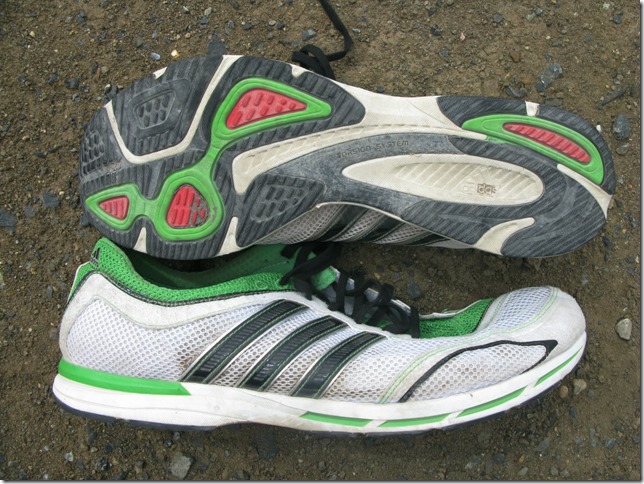
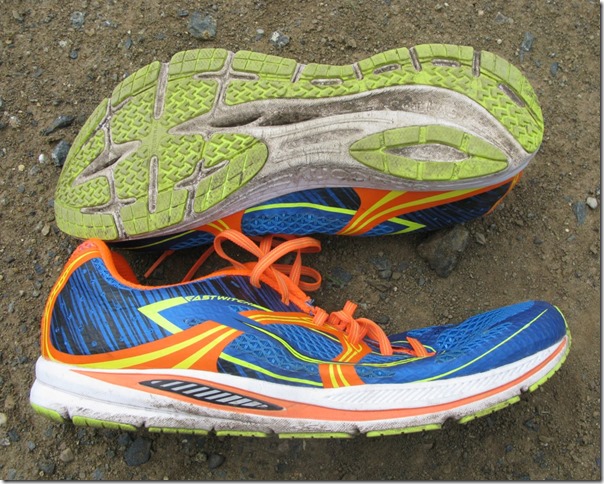
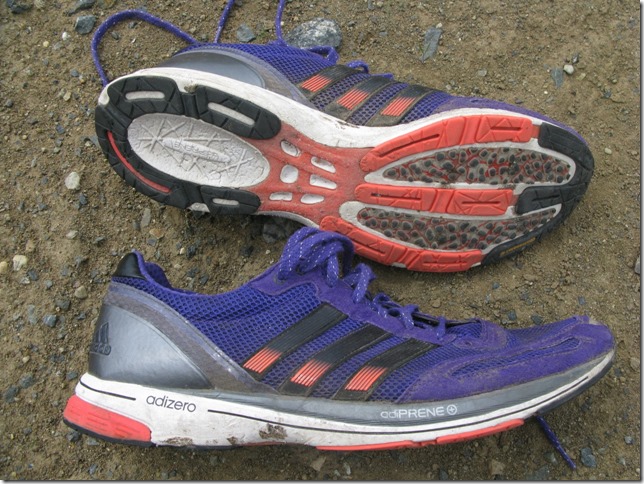
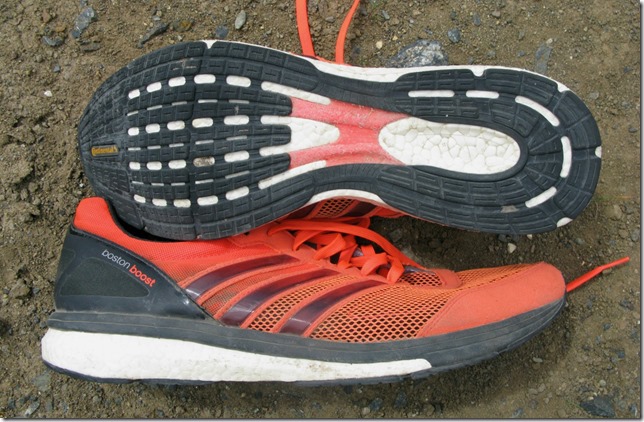
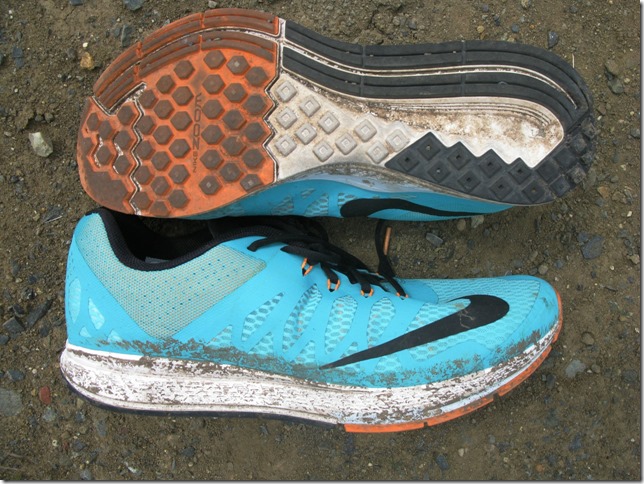
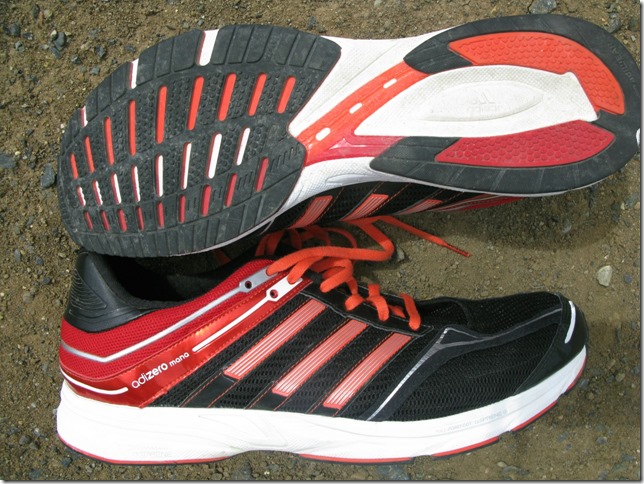
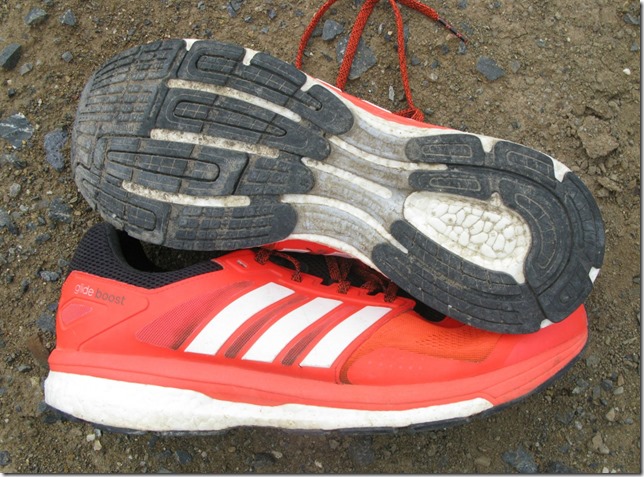
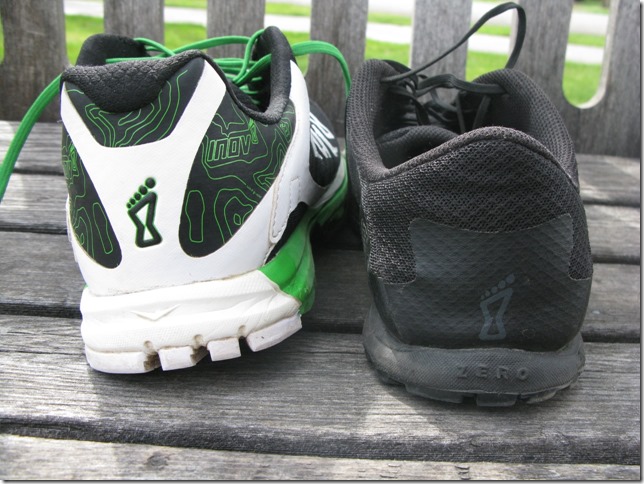


















Great post. It’s always interesting to see what the elites are running in. I noticed my favorite runner Rob Krar wore LunarTempos during Western States. I’ve never worn road racing shoes on trails, but seeing Krar knock out 100 miles in Lunarglides last year and LunarTempos this year has made me consider it. Perfect timing on your post. Thanks!
Pics I’ve seen look like Krar is rocking Lunaracer+3 at this years WS (maybe he switched between a few). None of the 3 TNF runners I saw wore TNF shoes.
Bought a pair of Lunaracers on ebay cheap and also trying out NB1500 and Boston Boosts on trail. Thanks for the good read.
Yep Krar was in Lunaracer and or trainers (only saw him in the dark at the start, haha, so hard to see). Boston 5 and Glide 7s were great.
After reading “Born to Run” and learning about the Stanford team as well as Kenyans, I have been using Free 4.0 on the trails. Granted, it isn’t as rough as the mountains but I have a good feel for the ground.
I echo the call to bring back the Rocket! (And curse you, David, for finding the last known size 13 in existence before me!)
Haha. Sorry Will. Yeah the Rockets are really sweet. One of the best flats ever made IMO.
David,
Congrats on the finish and a highly interesting article- I’d definitely second your experience- back in the early 2000s we would run European mountain ultras in the very same shoes just because the trail shoes available were rather clunky.
Christian, Thanks for the comment. Unfortunately, I dropped at Western at mile 78 for a couple reasons that I hope to share in a future post soon. That said the shoes were great and not related to the drop. Thanks for the support. -David
Great post. I think the trail shoes it’s just a trend and another way to sell shoes: you run on trails? they you need trail shoes too. Thing is 20 years ago when I began running there weren’t trail shoes and I was using (and still use) road shoes for easy trails. On more difficult and techinical trails trail shoes are welcome, but no, you don’t have to use trail shoes every time you leave roads, you can do a lot with “road” shoes.
Agreed!
20 years ago, there was the Adidas Response Trail, which got great reviews back then. I tested a pair of the second version (I think) on at the local running store and I still remember my amazement at how great they felt to run in – the best road or trail shoe I had tried up to that point, by far. I had been running 10+ years by then, and it might have been my first purchase of a running shoe at full price. I got at least a couple more pairs of the same model, but then moved on when Adidas started using a narrow last that I couldn’t get my feet in.
I’ll also say you don’t need road shoes at all either if you run both trails and asphalt. Road shoes are just a way for shoe companies to sell another shoe. I love my Hoka Challenger ATRs on the road too…
I agree that one can cross over road shoes for trail or trails shoes for road depending on preference with some shoes being more versatile than others. Interesting you mention the Response Trail. I’m running a pair of the forthcoming Response Boost TR which is a new model for this fall and I’m pretty happy with it and it has a much more roomy fit compared to other adidas so might be one that you might enjoy. I have a review posted soon hopefully. -David
I too want the rocket brought back! I bought mine in 2010 and have yet to find a worthy replacement for them. If I could just find something to patch some small areas of worn down outsole rubber they will probably be with me for a couple of more years.
You might consider the Shoe Goo option Steve suggest below. I haven’t tried it myself yet, but have heard from others that it can help prolong life of a shoe. Long live the Rockets! :)
Thanks for the advice! I’ll check it out if it’s available in Sweden.
The Rockets were not durable at all for me. I had several inch long tears in the uppers by 200 miles in my pair.
I agree on the uppers. Generally speaking thought, the midsole and outsole were very durable for a 7 oz racing shoe and that is more what I was referring to in regards to durability. -David
I second the Fastwitch. I ran up Half Dome in those, no problems at all.
You can’t beat Nike Lunar Racer 3 and Tempos for dry hard trails! I use them for short trail races out here in AZ. The Montrail Fluid Flex 2, and ST run like road shoes, but got nice grip. The ST has become my go to trail trainer on rocky trails! Looking forward to trying the Asics Super J 2 and New Balance 1600 2 (light & great looking tread). I found using Shoe Goo and cutting that foamy pipe insulation to fit in the holes they put in mid soles now a days works great. Just build up a couple layers over the patch after you glue it in. I guess old mid soles would work too. Great post as I like light comfy road shoes for trail racing! :)
Thanks for the info. I’ve been curious to try the Montrail Fluid Flex ST as I’ve heard a lot of good things about them. I’ve also heard the Shoe Goo recommendation before as well…might have to give that a try too! -David
I agree that the New Balance 1400s are excellent on trails.
In 1996 I spent a few days with Ann Trason for a Running Times story. She did her trail running in that era’s Nike Skylon TC, which was pretty similar to the New Balance 1400. I asked her why that instead of the Nike trail shoes she was in an ad for. She said, “A good shoe is a good shoe, period.”
Thanks for sharing Ann’s comment. What a runner!
Apparently she wears Hokas these days
Very interesting article, thank you :) I´m wearing road shoes on trails too, because many trail shoes feel clunky and hard to run in. I recommend: Mizuno Ronin 3 (old but gold), New Balance 890 v2-5 (not much protection though), Saucony Kinvara 3+5 (wears too quickly), Asics Nimbus 15 (clunky but lovely), Mizuno Evo Cursoris (wears down fast but is great), Mizuno Sayonara 2 (stiff, firm, great) and Saucony Triumph 9 (heel fit is shit, rest great).
But there are indeed some trail shoes that I love: Mizuno Ferus, Skechers Gorun Ultra :)
I agree that many trail shoes feel clunky. I’ve gotten used to very light shoes and aside from the drawback of how a road shoe handles mud, I haven’t bitten the bullet and purchased a trail show. I’ve actually considered get a more minimalist shoe to run the trails. That said, I have run more than 10 miles on trails in minimalist shoes but I am ramping up.
I use the Hitogami 2 instead of the Sayonaras because they are a great compromise between pure race flat, and neutral trainer with what looks like a very durable sole (same on the Sayonaras, I guess?). What’s your experience in mud/rain? The Hitogamis don’t offer much grip in wet conditions at all.
Interesting to see your using the Cursoris for trails. A shame they are so hard to find these days. Makes you wonder why Mizuno discontinued their zero-drop models (Levitas, Cursoris), and don’t offer a well cushioned low drop shoe anymore.
hi david,
very interesting article. re adidas, i was very happy running trails as well as roads in the boston 3, inter alia.
good to hear about the change to the zoom elite 7. have you tried the elite 8? i know the upper is different; i wondered how the fit and ride were affected by this and any other changes. thought i might give the refurbished 7 or the 8 a shot (just in case i can’t find the rocket…).
thanks,
bruce
I haven’t tried the Elite 8 yet, but from all info I’ve seen the upper is the only change over the refurbished 7’s that I ran at Western Sates. I don’t have any large gripes with the fit of the 7s, but will eventually try the 8s at some point I’m sure and yes they do provide a nice balanced and versatile shoe for many types of runs. -David
Well…so far out of the road shoes I mentioned in my post above — Lunaracer+3 winning out. Wider toebox than Adidas and cushier than NB…feel more stable to me than the LunarTempo, too. I can see why Krar likes them for the long haul..forefoot is nice and wide for a stable platform and traction isn’t bad at all on dry or slightly wet trails. I got them .5-1 size up for nice toe room. So light too. Going the other way — Trail shoes that are like road shoes — I am a big fan of the Patagonia Everlong and the Lunaracers feel like a lighter slightly less stable version.
Thanks for the input. I will say, the toebox in the lunaracer doesn’t seem wider (actually narrrower to me) than adidas if you are in the same size and I’m usually not a fan of sizing up if I can help it. That said, I can see the attraction to the Lunaracer regardless, just not a wide enough fit for longer runs and too soft for short stuff for me.
Do you know if is there any difference in toebox width between LunaRacer and LunarTempo?
From pictures, LunarTempo seems a tiny bit wider, but I don’t know if it would be enough to overcome the narrowness of LunaRacer.
I’ve tried on the LunarTempo and did not feel it to be noticeably wider than the Racer…a little more shoe but very similar fit to me unfortunately. -David
The Lunar Tempo is a lot looser than the Lunaracer. The Flywire seems to be more effective in the racer as opposed to the tempo. Additionally the tempo feels as though there is spillover while the racer is a more snug, cleaner fit.
Here’s a tip I picked up from Bryon Powell of iRunFar: Use the removable rock plate from a pair of Altra Superiors in a racing flat. I’ve tried this out with my NB RC1600s and it works great!
I saw that from this year at Hardrock. Still can’t believe he ran the entire thing in the 1400v3, rock plate added or not!
Great post! I always giggle a little inside when I pass other runners on the trails wearing burly, heavily lugged shoes on the typically well packed dirt trails we have in most places. Kinvaras have worked just fine for me. But, I do love trying different running shoes, even when I’m happy with the current stable. And glad I do!
The latest “discovery” for me is the Salomon S-Lab X-Series: it has become my go-to shoe, for everything. Super light, that incredible Salomon fit, very breathable, highly flexible, and a full rubber outsole with great traction in all things but deep mud. It’s a road shoe from a trail shoe company. An interesting mix. Max King ran the LA Marathon in them.
Planning on running both Wineglass and the JFK50 in these.
But, yes, since the ethos of trail running here in the US is more about staying on trail, a good road works just fine. No need for overbuilt “fell running” sorts of things.
Agreed! Haven’t tried the X-Series myself but hear good things. Hardest issue with X-Series in my mind is price at $160 for what is essentially a road racing shoe. Regardless, not surprising it works well on trails :)!
The price is a bit steep, agreed. But after 600+ miles in them (~200 on the AT and ~100 on kinder trails) I see why. They are still going strong with no sign of needing to be retired yet.
My beloved Kinvaras tend to disintegrate at 280-350, road miles.
When I bought them I thought I was paying premium for the euro-ness, and maybe I was (or paying for Kilian). The build quality, fit-and-finish, is second to none, however. They’ve proven their worth and their mettle. YMMV.
As is often repeated in cycling circles, “Light, durable, cheap: pick two.”
You’ve got me looking at some of those Adidas with the Conti outsoles now. My Conti bike tires last a very long time. Hmmm…
Great info on the X-Series. I saw their update at Outdoor Retailer last week, the S-Lab Sonic and my interest is re-peaked in them and yes Salomon construction and build quality is top notch. Conti rubber is likely my favorite (vibram has some good stuff too) and very durable…a shoe like the Glide 7 will last super long (1000+ miles easy) with the conti rubber and boost midsole and I’ve had great luck with my Bostons and adios.
Hi! Would love to have an update in case you’ve tried other road shoes for trails :-) Thanks!
Thanks for your comment. I haven’t tried too many other road shoes recently that have worked out great for trails. One that I didn’t mention in the post but works good for smoother trails is the New Balance Zante (though I’d wait for v2 to come out in a few months). Also, I just ran across a preview for the adidas adios 3 here; link to youtube.com Looks like a fantastic option coming soon as does the Streak LT 3: link to youtube.com for shorter trail runs and races. Due to the popularity of the post, I’ll likely do another one next year when I’ve had a chance to try these and others out on the trails!
Thanks for reading,
David
Looking forward the 2016 post. Thanks!
Do ya reckon the Inov-8 Roadclaw 275 would have enough protection for moderate trail?
Looking for something with a wider toe-box, something the above flats don’t have.
The Inov-8 Roadclaw 275 has decent outsole coverage, with a few large flex grooves, not sure is these would be an issue?
Stack height is only 1mm lower than NB1400 at forefoot. What do you think?
Hey Jake,
Sorry, I didn’t see your comment until just now…not sure how it slipped through. I’ve run the Road Claw 275 and I think it would do ok on smoother trail. I worry about the podded outsole long term but it should be ok if the trail is not too rough. Have you tried the Nike Zoom Elite 8? Feels pretty wide to me and I really like the upper feel and overall ride on that shoe for moderate trail. -David
Differences between the boston and supernova glide boost? Is it just in the upper fit? Is the Boston as protective and is it more flexible?
There are quite a few differences between the Boston and Glide. First the fit of the Glide is more generous and roomy and they are on different last shapes. They both fit medium width with the Glide having more comfort in the upper since it is more the trainer of the two. The cushioning and ride is quite a bit different too with the Glide being much more substantial, protective and stiffer…it is just more shoe overall. I like both of them and since they are quite different and have different uses. The Boston is adequately protective and it is quite a bit more flexible (even more flexible than the adios), but the Glide is more protective and super durable. Hope that helps! -David
Coming to the 1 year anniversary of this article… maybe the update is due? :-)
Got a post in the works…just wanted to have a good crop of new shoes to highlight :). -David